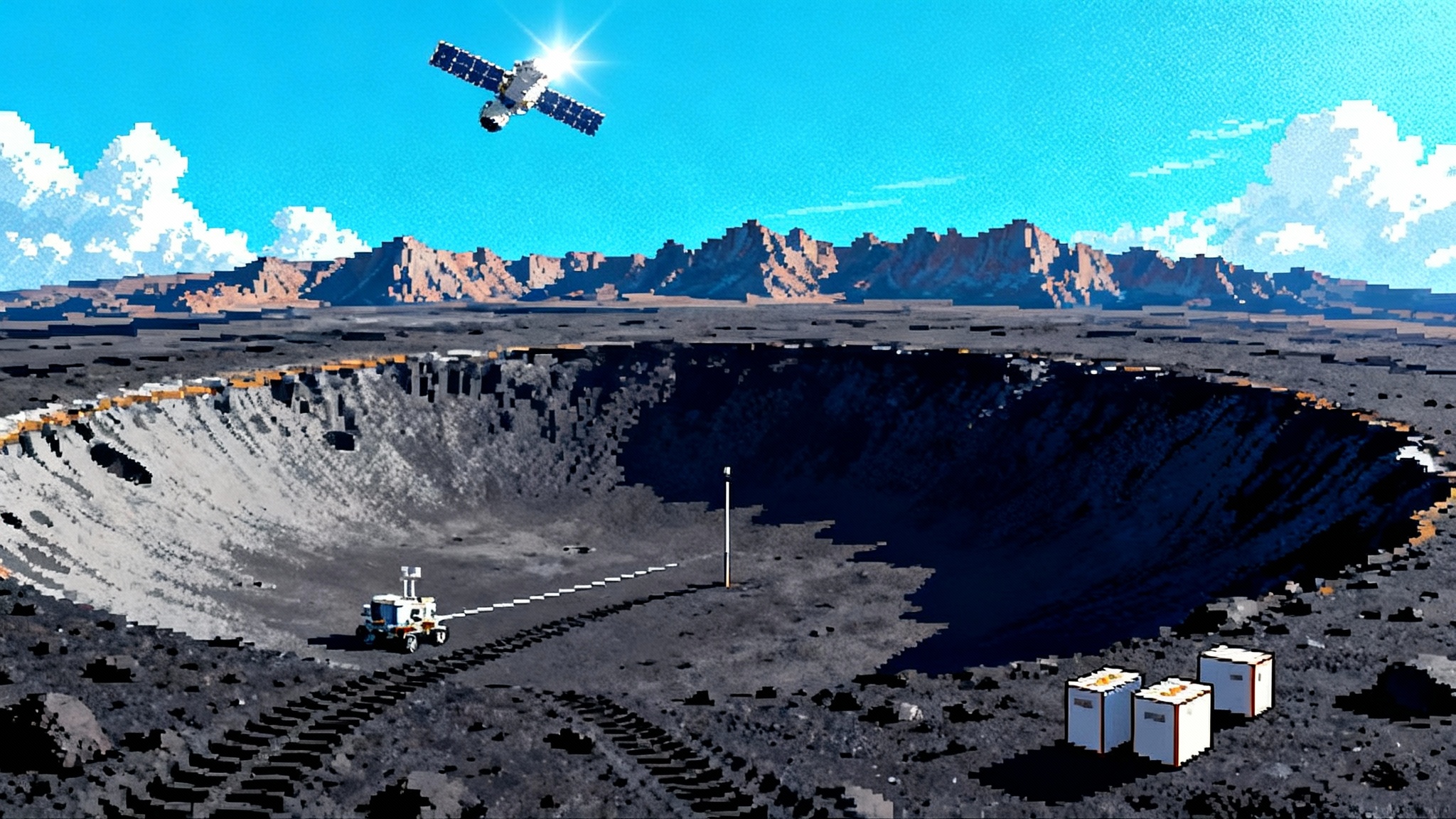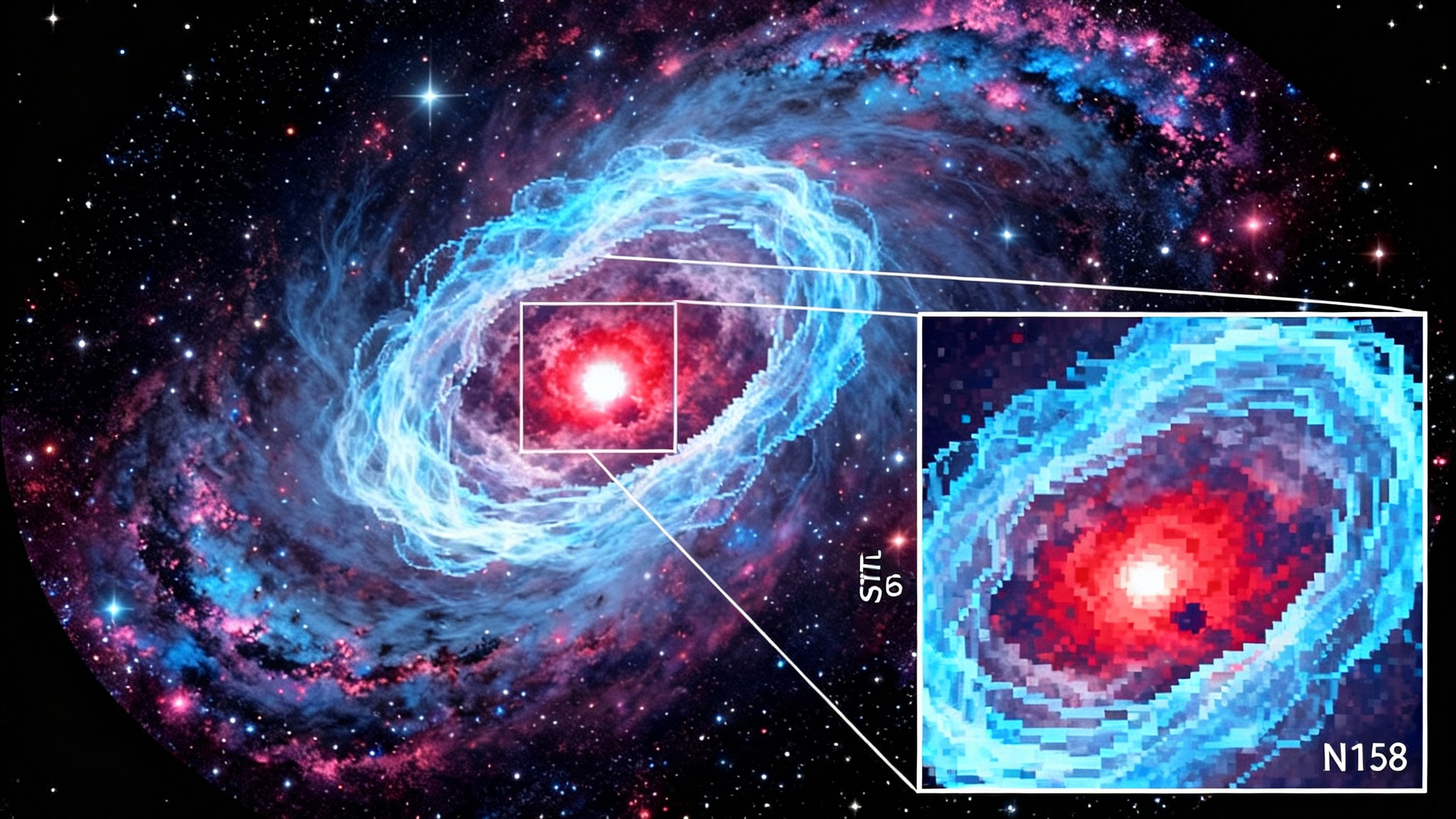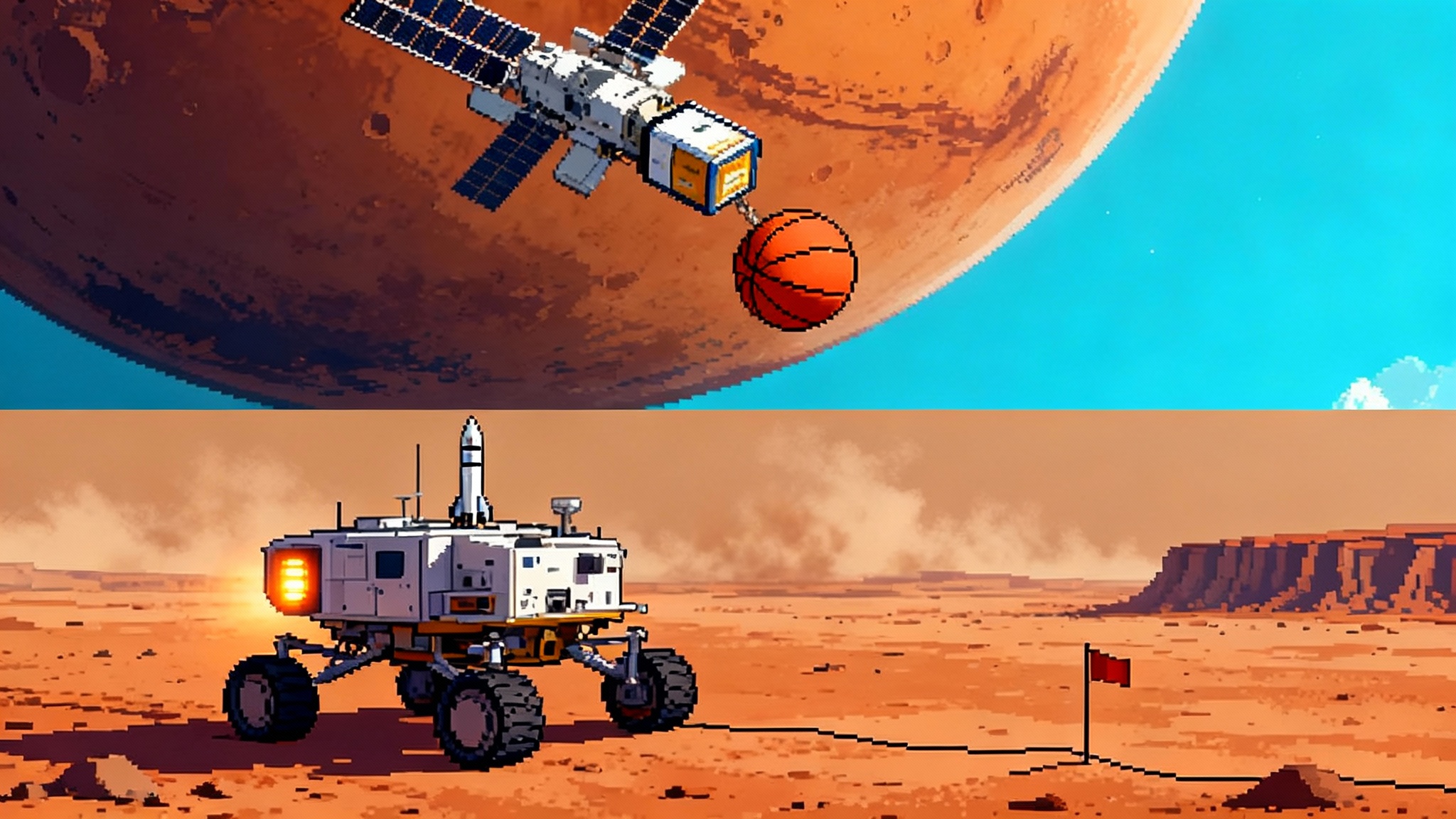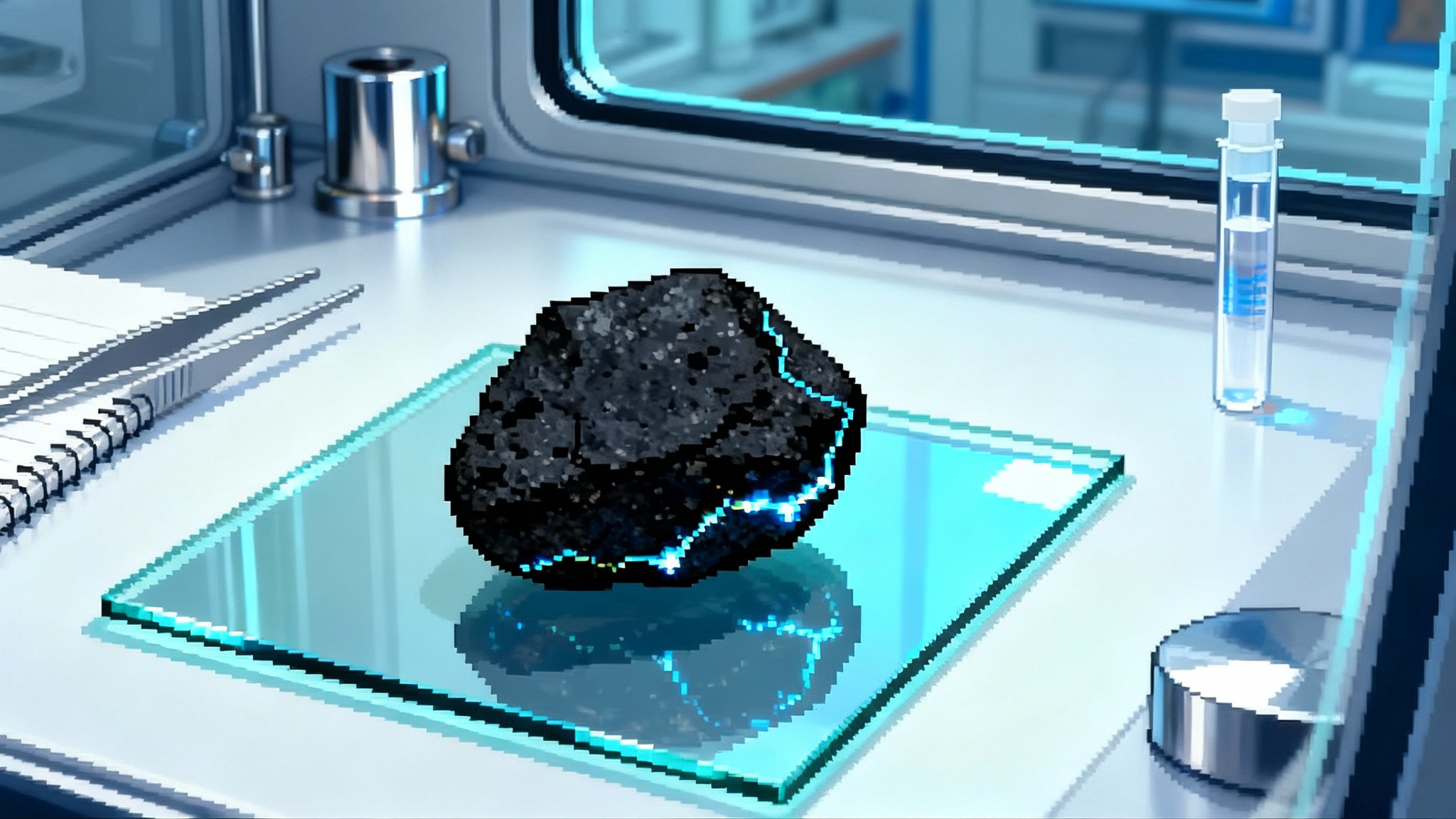3I/ATLAS Turns the Solar System into a Shared Observatory
As interstellar comet 3I/ATLAS sweeps through the inner Solar System, Mars orbiters, JUICE, Hera, Europa Clipper, and Earth telescopes are coordinating to read its ion tail like a lab experiment. Here is how a distributed observatory can decode an alien birthplace and why a rapid response interceptor should be next.
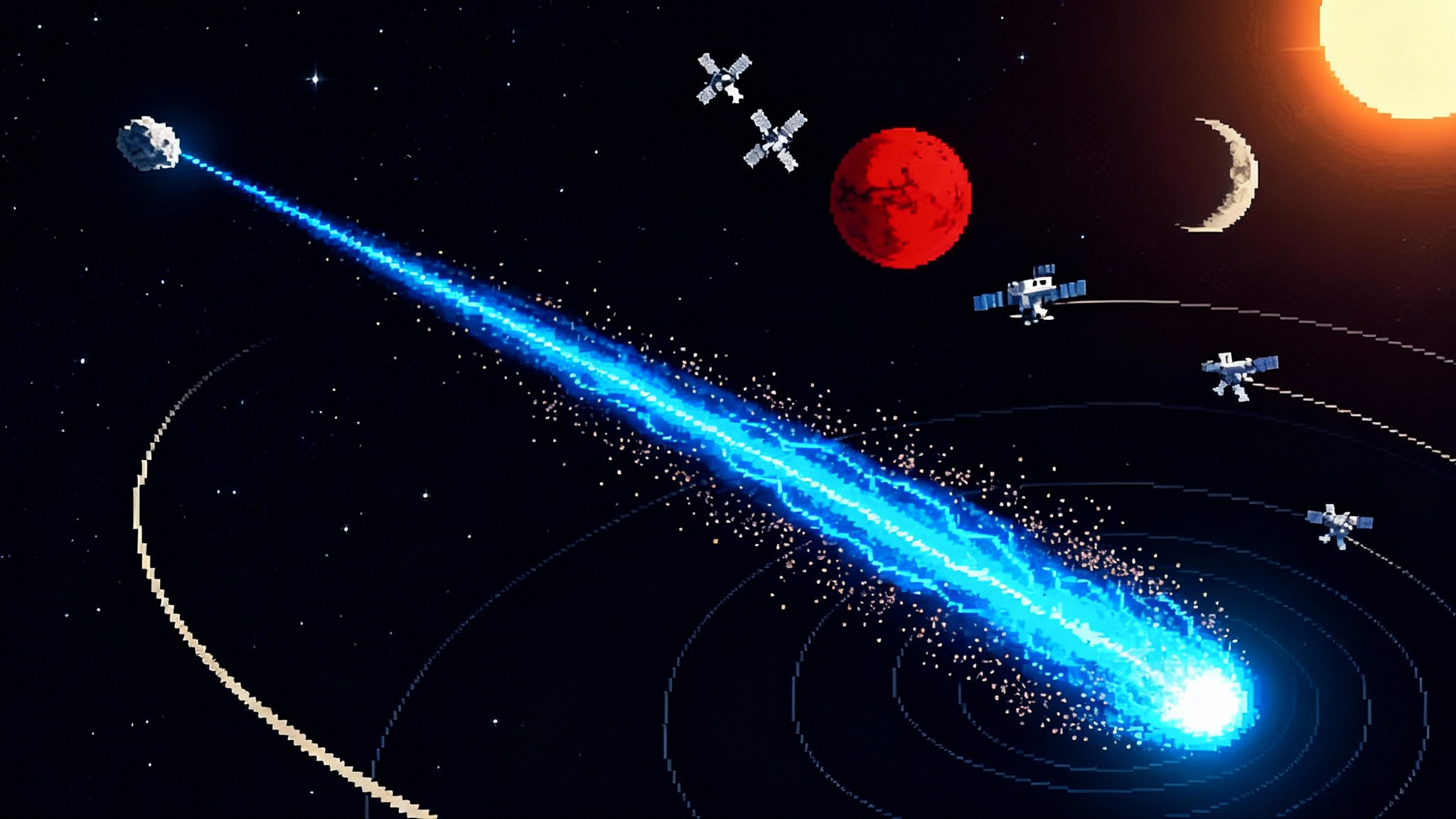
A visitor from elsewhere, a network at home
By the time the blue ion tail of 3I/ATLAS began to unspool across the inner Solar System this October, the interesting question was no longer whether we could see it. The pressing question was how quickly we could turn every platform we have into a single, coordinated instrument. In late 2025, that is exactly what is happening. Mars orbiters swung their cameras and spectrometers to catch the first structure in the tail during the first week of October. In mid November, the European Space Agency’s Jupiter Icy Moons Explorer, better known as JUICE, is using its cruise-phase instruments to read the ion tail’s composition at medium range. And as the geometry keeps changing, brief crossings of the outer tail by ESA’s Hera spacecraft and NASA’s Europa Clipper remain possible over the next few weeks, which could add in situ dust and plasma sampling to the record.
Think of it as astronomy by swarm, except the swarm is the fleet we already fly. No single spacecraft was launched for this comet, and none sits in the perfect place. Yet together, they can do something that one purpose-built probe might not. By sampling the tail at different distances from the nucleus and at different angles to the solar wind, they can separate local weather from intrinsic chemistry. That is what makes this moment historic. If the tail truly carries the fingerprints of a different nursery of planets, a distributed observatory is our best chance to read them in full.
October: Mars gets the first look
A comet tail is a conversation between ice and sunlight. The closer the nucleus gets, the more volatile molecules sublimate into gas, which then gets stripped and ionized by the Sun’s ultraviolet light and the solar wind. The result is a blue, straight ion tail that points away from the Sun and a broader, dust tail that curves along the orbit. Early October 2025, Mars happened to sit in a geometry that placed its orbiters off to the side of 3I/ATLAS, offering a slanted view through the ion tail.
From that vantage point, instruments on the ExoMars Trace Gas Orbiter and Mars Express could do two things at once. High cadence images resolved the tail’s changing structure, which is driven by the shifting direction and strength of the solar wind. Spectrometers looked for classic ion emissions that tell you which molecules are present: carbon monoxide and its ion CO+, nitrogen in the form of N2+, as well as fragments like CN and OH that trace the breakdown of more complex species. If the tail’s spectrum showed a relatively strong N2+ line compared with CO+, for example, it would suggest that the comet formed in a region of its home disk that was cold enough to trap nitrogen efficiently. If CN stands out, it might point toward abundant nitriles, the same chemical family that includes some prebiotic molecules.
The Mars perspective is powerful because it is offset from Earth. When two observers view the same structure from different angles, parallax reveals the three dimensional shape of the tail’s folds and kinks. This is like watching smoke from a campfire while you walk around it, then using your two photos to reconstruct how the wind pulled the plume in space and time. With Mars doing the walk and Earth doing the watching, researchers can subtract the space weather and see what is left over. For context on the solar wind’s role during solar maximum, see our overview of a live heliosphere map at solar maximum.
November: JUICE reads the tail’s recipe
In mid November 2025, JUICE moved into a sweet spot, not for images but for chemistry. JUICE carries a suite of plasma and particle sensors as well as spectrometers that can sniff ions and neutrals during cruise. While the spacecraft is bound for Jupiter, the ion tail of 3I/ATLAS drifted close enough to the spacecraft’s line of sight that it could measure the flux and energy of ions and pick out their mass signatures. That is like a restaurant critic walking past the kitchen vents and recognizing the menu from the aromas.
The most revealing numbers are ratios. The carbon monoxide to nitrogen ratio points to formation temperature. Deuterium to hydrogen in water and hydrogen cyanide shows how cold the comet’s nursery was and whether its ices formed from interstellar inheritance or disk chemistry. The abundance of noble gases like argon and neon, if seen, can reveal trapping mechanisms within the comet’s amorphous ice. In principle, JUICE can detect ions like H2O+, CO+, and N2+, and can sample the electron environment that shapes the tail. Together, those data constrain how easily ultraviolet light ionizes the escaping gas and how the solar wind’s magnetic field drapes around the comet. That magnetic drape controls where reconnection might cut and reattach field lines, which in turn creates the bright, moving knots seen in long ion tails. For readers who want the hardware context, you can browse an overview of ESA’s JUICE instrument suite to see how a Jupiter mission ends up doing comet chemistry during cruise.
Critically, JUICE is not alone. Ground based networks are feeding timing to the spacecraft teams. As the Sun rotates, the spiral pattern of its magnetic field sweeps over the tail. If Mars orbiters report a fold or a disconnection event, JUICE engineers can match the timing and see whether a spike in ion counts at JUICE aligns with the same solar wind structure. This will let scientists distinguish the comet’s outgassing rhythm from space weather’s whip. Expect rapid alerts from real time sky surveys this decade to help synchronize observations.
Skimming the tail: Hera and Europa Clipper
Unlike Mars and JUICE, Hera and Europa Clipper are both racing toward their own targets, with tight navigation margins. That makes their involvement both tentative and exciting. As of today, November 9, 2025, mission teams are analyzing whether the diffuse outer part of the tail might briefly cross each cruise path later this month. If it does, even a shallow immersion could deliver valuable measurements.
Hera does not carry a full plasma suite, but it does carry sensitive cameras, star trackers, and thermal sensors that are constantly measuring the spacecraft’s environment. A tail crossing could show up as a burst of tiny dust impacts detectable in accelerometer or thermal noise, a transient glow on star tracker frames, or a change in spacecraft charging that shows up in housekeeping telemetry. None of those are classical comet instruments, yet together they could confirm grain sizes and densities in the outer tail.
Europa Clipper is better equipped for gas and plasma. Its sensors can count ions and electrons and read their energies, and its mass spectrometer is designed to characterize tenuous atmospheres and plumes. In a brief tail graze, Europa Clipper could detect H2O, CO, CO2, and heavier organics if present in the tail’s neutral component, while its plasma instruments characterize the ionized fraction and the dust analyzer counts and sizes particles that impact the instrument. The key is coordination. If Mars orbiters and JUICE report a tail disconnection or a surge in CN emission, Clipper can align its sampling windows to that timing and maximize the odds of catching a compositional change rather than a bland average. To see why those sensors matter, it helps to review the payload, which you can scan on NASA’s Europa Clipper instruments page.
Why ion tails are cosmic thermometers
Every interstellar comet is a survivor of a different origin story. Ices record temperature and pressure as faithfully as tree rings record droughts. When ultraviolet light and the solar wind ionize that ice as it escapes, the ion tail becomes a traveling spectrometer slide. If you know which lines to look for, you can read:
- Nitrogen to carbon monoxide: colder disks trap more nitrogen, so a high N2+ to CO+ ratio points to a frigid birthplace.
- Deuterium to hydrogen in water: high values suggest very cold formation or inheritance from the molecular cloud that birthed the star.
- Cyanide and other nitriles: these trace the availability of carbon and nitrogen in the disk and whether ultraviolet processing built prebiotic molecules before the comet ever formed.
- Noble gases: argon and neon are hard to trap, so their presence speaks to the ice’s physical structure and to pressures during formation.
The tail also encodes physics. The way it bends and kinks tells you about the solar wind and the shape of the Sun’s magnetic field. Disconnection events, where the tail seems to snap and regrow, mark magnetic reconnection, the same process that powers solar flares. By comparing what Mars sees in October with what JUICE, Hera, and Europa Clipper measure in November, we can separate what belongs to the comet from what belongs to the weather.
The fleet we have is not the fleet we need
This moment is beautiful, but it is also lucky. None of these spacecraft were designed to chase an interstellar comet. The geometry happened to line up. The teams were nimble enough to reprogram observations, rework pointing constraints, and share timing. That is not a sustainable plan. Interstellar visitors are rare and fast. To learn the most from the next one, we need a program that is ready on day one, not month three.
Call it an Interstellar Rapid Response capability. It would sit on the shelf, paid for and maintained, with a standing launch contract and prequalified components. The moment a survey pipeline posts an object with an interstellar trajectory, a clock would start. Within days, a small interceptor would launch on a direct trajectory to the object’s coma, carrying a minimal but surgical payload to read composition and structure up close.
What a ready to launch interceptor looks like
- A standardized bus: think a 200 to 400 kilogram platform with proven avionics, fault tolerance, and radiation shielding sufficient for inner Solar System operations.
- A high performance kick stage: a compact upper stage, stored loaded, with thrust to make impulsive burns within days of detection. This is the bottleneck that turns knowledge into proximity.
- A simple, pointed payload: one ultraviolet visible spectrograph with high throughput, one compact mass spectrometer for ions and neutrals, one dust analyzer for size and composition, a wide field camera for context, and a plasma package for field and particle measurements. No redundancy, just reliability and calibration.
- Autonomy and optical navigation: onboard processing that can lock onto the coma against star fields and adjust the trajectory for a close pass without overtaxing the deep space network.
- A mission kit for operations: a prebuilt flight plan template, a ground system that can spin up shifts within hours, and an interagency data exchange that makes calibrated spectra available to the community in near real time. Fast data return can lean on maturing deep space laser links.
Everything on that list exists. The trick is to package it, test it, store it, and keep it warm. The return on investment is asymmetrical. One successful flyby would tell us how planets form elsewhere, how organic molecules travel between star systems, and whether our own cometary chemistry is typical or strange.
Paying for speed and choosing tradeoffs
Speed costs money, but not the kind of money we spend on flagships. The core costs are in standing readiness and in a launch that might not happen every year. You can cut risk by building two identical interceptors and staggering their maintenance. You can share costs by standardizing the bus with other small deep space missions. You can place the kick stage and bus at a parking orbit where quick access to sunlight and communications is reliable. You can pre negotiate ride share options and a dedicated small vehicle slot.
The biggest tradeoff is payload ambition. Adding instruments multiplies interfaces, mass, and calibration time. It is better to fly a simple, robust set of five instruments at high cadence than to dream of a full laboratory. Ion tails reward speed and timing more than complexity. The scientific community can do the rest by aiming every telescope and spacecraft we have at the same object and braiding the measurements together.
How this campaign changes comet science
If the late 2025 campaign lands the way it could, we will have the first truly multiscale look at an interstellar tail. Mars orbiters provide texture in early October. JUICE brings compositional ratios in mid November. Hera and Europa Clipper, if their paths clip the outer tail later in November, add grain sizes, dust impacts, and plasma structure from inside the flow. Earth based telescopes and solar observatories fold in yet another angle. Put together, the data set becomes a three dimensional, time dependent atlas of gases and fields from a body that did not form here.
Two results would be transformative. First, a nitrogen rich signature would suggest that 3I/ATLAS formed in a very cold region, perhaps beyond the nitrogen snowline of its parent disk. That would imply that disks make a lot of nitrogen rich planetesimals, a clue that shapes how atmospheres get their starting inventories. Second, a high deuterium to hydrogen ratio in water would tell us that some comets in other systems inherit their water from the interstellar medium rather than cooking it up in the disk, which would have implications for when and how habitable planets get hydrated.
Even a null result teaches. If 3I/ATLAS looks like 2I/Borisov and like our own long period comets, the boring answer would be the bravest one: planet formation may be a universal recipe with familiar ingredients. That would not diminish the value of a rapid response program. It would prove that speed is how we learn fast and rule out bad ideas early.
What to watch next
Over the next two to three weeks, pay attention to three signals. First, do Mars orbiters and Earth based spectrographs report a repeatable pattern in CN and CO+ emissions as the Sun’s magnetic field rotates. Second, do JUICE measurements in mid November show correlated spikes in ion counts that line up with tail disconnection events seen by imagers. Third, do Hera and Europa Clipper record any deviations in dust or plasma measurements during their possible brief immersions late in the month. If any pair of these line up in time, we will have a baseline for modeling the tail in three dimensions and for separating composition from weather.
The case for acceleration
This campaign proves that a distributed observatory can catch an interstellar visitor on the fly. It also proves that luck should not be a strategy. The solution is practical and measurable. Fund a standing interceptor capability with a fixed annual cost, two shelf ready spacecraft, a prearranged launch, and a shared operations kit. Fold it into the cadence of existing surveys that feed discovery alerts to the Minor Planet Center. Train mission teams to pivot, build checklists for pointing and safety, and prewrite the data pipelines that turn raw spectra into public plots within 48 hours. Align with real time sky surveys this decade so that the fleet can pivot fast when the next alert arrives.
A shared eye for a shared sky
3I/ATLAS is a reminder that our Solar System is not a closed room. It is a porch with a good view, and every so often a traveler passes by. In October and November 2025, we used what we had and turned the porch into a lab. Mars grabbed the angle. JUICE read the recipe. Hera and Europa Clipper may yet feel the tail’s touch. The lesson is simple. When the universe hands you a puzzle, move fast, move together, and bring the right tools. Then, the next time an interstellar visitor cuts across our sky, we will not just watch it. We will meet it halfway.

